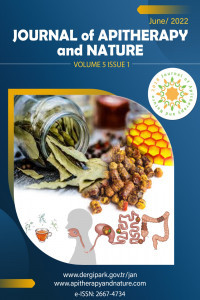An Overview of Chemical Studies and Biological Activities of Mediterranean Propolis
An Overview of Chemical Studies and Biological Activities of Mediterranean Propolis
Propolis, Biological Activities,
___
- 1. Papachroni D., Graikou K., Kosalec I., Damianakos H., Ingram V., Chinou I. (2015). Phytochemical analysis and biological evaluation of selected African propolis samples from Cameroon and Congo. Natural Product Communication, 10: 67-70. 2. Popova M.P., Graikou K., Chinou I., Bankova V.S. (2010). GC-MS profiling of diterpene compounds in mediterranean propolis from Greece. Journal of Agricultural & Food Chemistry, 58: 3167-3176. 3. Graikou K., Popova M., Gortzi O., Bankova V., Chinou I. (2016). Characterization and biological evaluation of selected Mediterranean propolis samples. Is it a new type? LWT-Food Science and Technology, 65: 261-267
- Yayın Aralığı: Yılda 2 Sayı
- Başlangıç: 2018
- Yayıncı: Oktay YILDIZ
Some Apitherapeutic Properties of Chestnut Propolis
Sevgi KOLAYLI, Saliha EKSI, Zihni YAZICI, Oktay YILDIZ, Hüseyin SAHIN, Zehra CAN, Sengül KARAOGLU
Fatty Acid Analysis and Biological Activity of Jordanian Propolis
Ashok K. SHAKYA, Shankar KATEKHAYE, Ghaleb A. ORIQUAT, Rajashri R. NAIK, Rajashri R. NAIK, Anant PARADKAR, Hugo FEARNLEY, James FEARNLEY
Isolated Triterpenes from Stingless Bee Lisotrigona furva Propolis in Vietnam
Le Nguyen THANH, Vu Thi Kim OANH, Ha Thi THOA, Diep Thi Lan PHUONG, Nguyen Thi Phuong LIEN, Tran Huu GIAP, Nguyen Thi Minh HANG, Nguyen Van HUNG, Vassya BANKOVA
Determination of Phenolic Acids in Raw Propolis Using Near Infrared Spectroscopy
Ana María VIVAR-QUINTANA, İsabel REVILLA, María İnmaculada GONZÁLEZ-MARTÍN, Eddy Valentín BETANCES-SALCEDO
What We Know, and Don't Know, about the Benefits of Propolis to Honey Bee Health
Chemical Profile of Greek Arbutus unedo Honey – Biological Properties
αrgyrο ANDREOU, Ioanna CHINOU, Konstantia GRAIKOU
Preliminary Evaluation of the Cytotoxic Potential of North-West Romanian Propolis
Constantin İ. MATES, Emoke PALL, Marina SPINU, Laura STAN, Mihaela NICULAE
İbrahim PALABIYIK, Didem SOZERI ATIK, Esra BOLUK, Sevgi KOLAYLI
An Exploration into the Relationship Between Propolis Production and Trypanosome Burden
Tim REGAN, Mark BARNETT, Tom FREEMAN
Effects of Propolis on the Quorum Sensing of Selected Biofilm Producing Bacterial Species
